|
|
|
Sort Order |
|
|
|
Items / Page
|
|
|
|
|
|
|
| Srl | Item |
| 1 |
ID:
144379
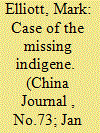

|
|
|
|
|
| Summary/Abstract |
The last few years have seen a vigorous public policy debate emerge over a “second-generation” ethnic policy (di’erdai minzu zhengce) which, if implemented, would constitute a major revision of ethnic politics in China. Despite the fact that nationalities policy is a notoriously sensitive subject within China, the debate is happening openly in newspapers, academic journals and on the Internet. The prominence accorded to anthropological theory and international comparison is a notable feature of the debate. This article first explores the main positions in the ongoing policy discussion, then goes on to argue that, rather than comparing China’s non-Han peoples to minority immigrant populations in the industrialized democracies, a better comparison is to indigenous peoples. It then considers why this perspective is completely missing from the present debate.
|
|
|
|
|
|
|
|
|
|
|
|
|
|
|
|
| 2 |
ID:
163319
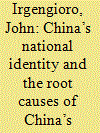

|
|
|
|
|
| Summary/Abstract |
This paper seeks to examine the People’s Republic of China’s (China) self-defined national identity and the consequences on China’s ethnic relations with its ethnic minorities. This paper argues that China’s identity is equated with the identity and culture of its ethnic Han Chinese majority—a narrative originally constructed by the Chinese state which its ethnic Han Chinese majority since indulges in. However, this hegemonic narrative is at the root of interethnic issues and tensions in China today, as further ethnic tensions stem from the resistance of ethnic minorities against Sinicization and the imposition of this “Chinese” identity against them. These phenomena thus both indicate what I term a weak “internal soft power appeal” of Han Chinese Confucian culture for ethnic minorities living in the PRC, and imply that China must adopt a different, more inclusive national identity if it were to maintain ethnic stability in the long term.
|
|
|
|
|
|
|
|
|
|
|
|
|
|
|
|
| 3 |
ID:
159545
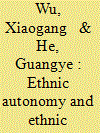

|
|
|
|
|
| Summary/Abstract |
To balance ethnocultural diversity with national integration, the Chinese government started formulating a series of ethnic policies in the early 1950s, including policies on identifying and classifying ethnic groups, a system of regional ethnic autonomy, and a set of preferential treatment policies toward 55 minorities. This article aims to examine socioeconomic disparities between ethnic minorities and the Han majority in China, focusing on the role played by regional ethnic autonomy. Based on a large sample of China's mini-census data collected in 2005, we show that among nonfarm working populations, minorities are more likely than the Han to become managers/professionals or obtain high-status occupation, regardless of whether they are living in their own autonomous jurisdiction or other places. Minorities are paid lower wages, however, even after controlling for other characteristics, and the gap is even wider in autonomous jurisdictions than elsewhere. Finally, children of mixed Han-minority marriages in ethnic autonomous jurisdictions are more likely to identify themselves as minorities, especially those holding urban registration status (hukou) whose parents have received more schooling. Our findings bear important implications for the current debate on ethnic policy in China.
|
|
|
|
|
|
|
|
|
|
|
|
|
|
|
|
| 4 |
ID:
118420
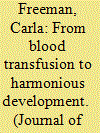

|
|
|
|
|
| Publication |
2012.
|
| Summary/Abstract |
For six decades, China's central authorities have promoted development in ethnic regions through special fiscal allocations with the idea that economic development is the key to national integration and inter-ethnic harmony. Yet, inter-ethnic tensions and violence persist in China. Focusing on historical changes to fiscal allocations as the principal policy instrument used by Beijing to promote development in ethnic areas, this analysis finds these changes mirror broad shifts in the country's national development strategy. As the study argues, this pattern reflects an approach to development policy in ethnic regions whereby policies serve central objectives consistent with a policy process for determining the fiscal allocations to ethnic regions that has been both centrally concentrated and non-participatory. With evidence that this "non-engaging" approach may be exacerbating ethnic tensions, Beijing has made efforts to introduce more "inclusive" approaches to determining policies for ethnic regions; however, whether these approaches will be institutionalized remains unclear.
|
|
|
|
|
|
|
|
|
|
|
|
|
|
|
|
| 5 |
ID:
140589
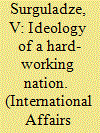

|
|
|
|
|
| Summary/Abstract |
THE GLOBAL ATTENTION to the reforms of the architect of Singapore's "economic miracle" is easily explained by the country's socio-economic successes. Lee Kuan Yew, the first prime minister of Singapore, is an iconic figure in the modern world. In many developing and industrial countries, he is regarded as a true economic and political guru. His book, From Third World to First. The Singapore Story: 1965-2000,1 has deservedly become a handbook for many state leaders.* What kind of a country is Singapore today and why does the experience of this small nation attract the attention of state leaders faced with questions of modernization and successful competition in the global market?
|
|
|
|
|
|
|
|
|
|
|
|
|
|
|
|
| 6 |
ID:
166878
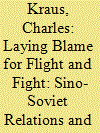

|
|
|
|
|
| Summary/Abstract |
In spring 1962, 60,000 individuals fled from northern Xinjiang into the Soviet Union. Known as the “Yi–Ta” incident, the mass exodus sparked a major flare up in Sino-Soviet relations. This article draws on declassified Chinese and Russian-language archival sources and provides one of the first in-depth interpretations of the event and its aftermath. It argues that although the Chinese government blamed the Soviet Union for the Yi-Ta incident, leaders in Beijing and Xinjiang also recognized the domestic roots of the disturbance, such as serious material deficits in northern Xinjiang and tensions between minority peoples and the party-state. The Chinese government's diplomatic sparring with Moscow over the mass exodus reflected Mao Zedong's continued influence on Chinese foreign policy, despite claims by scholars that Mao had retreated from policymaking during this period.
|
|
|
|
|
|
|
|
|
|
|
|
|
|
|
|
| 7 |
ID:
144978
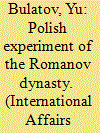

|
|
|
|
|
| Summary/Abstract |
TWO HUNDRED YEARS have passed since the Vienna Congress (1815) when Europe's leading monarchs led by the Russian autocrat Alexander I produced yet another scenario for the world following the routing of Napoleon Bonaparte's empire; the Congress determined also the status of Polish lands.
|
|
|
|
|
|
|
|
|
|
|
|
|
|
|
|
| 8 |
ID:
129457
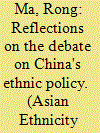

|
|
|
|
|
| Publication |
2014.
|
| Summary/Abstract |
'Minzu' (nation or nationality) is a term that appeared in China after the Opium Wars. From 1949, the PRC established a two-level national structure with the term 'minzu': the Chinese nation (zhonghua minzu) at the top and 56 nationalities (minzu) at the bottom. The PRC also adopted the Soviet model in regard to administration of and policies toward the minority 'minzu'. In recent years, amid increased tensions and conflicts among China's 'nationalities' (minzu), an ongoing debate among Chinese scholars has been observed. This paper reviews this debate and clarifies some misunderstandings among different viewpoints.
|
|
|
|
|
|
|
|
|
|
|
|
|
|
|
|
| 9 |
ID:
078195
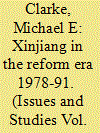

|
|
|
| 10 |
ID:
190825
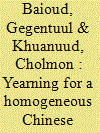

|
|
|
|
|
| Summary/Abstract |
This study examines the digital propaganda campaigns carried out by the Chinese Communist Party in Inner Mongolia following Mongols’ protest against the bilingual education reform in 2020. It analyses texts and images posted on WeChat official accounts of the Inner Mongolia Daily and Inner Mongolia Education Department. Through a detailed discourse and semiotic analyses of propaganda texts we reveal that the national unity and development discourses are replete with Han-centric assimilationist ideology. In our analysis, by drawing on a Bakhtinian chronotope, we foreground how the past, present and future are turned into a unified folkloric-cum-colonial space–time. This study also elucidates how the drastic policy shift and the re-articulation of national form in China is reflected in publicly circulated words and images in Inner Mongolia.
|
|
|
|
|
|
|
|
|
|
|
|
|
|
|
|
|
|
|
|
|